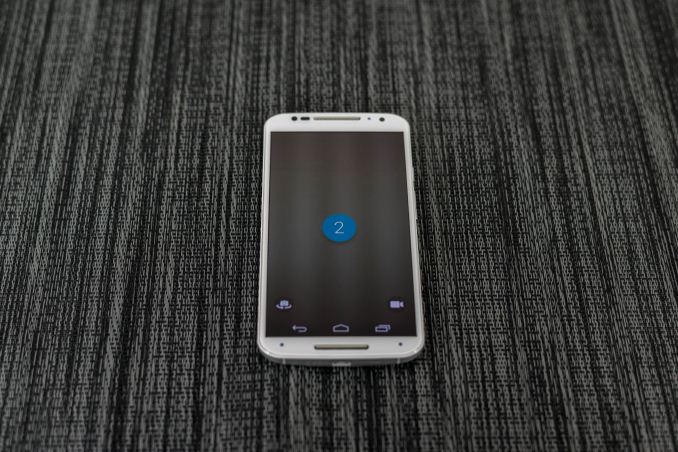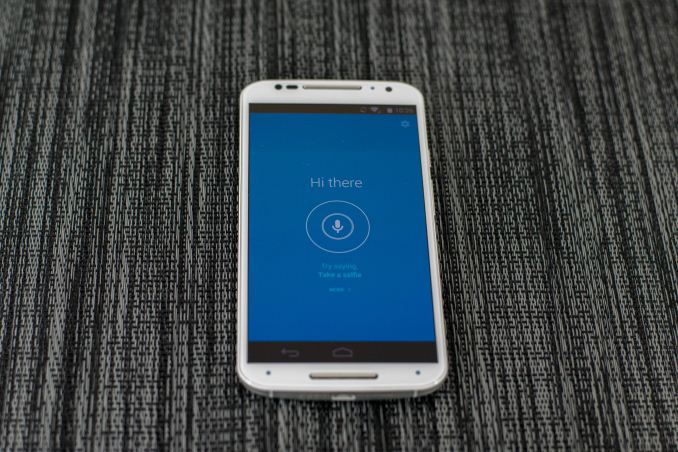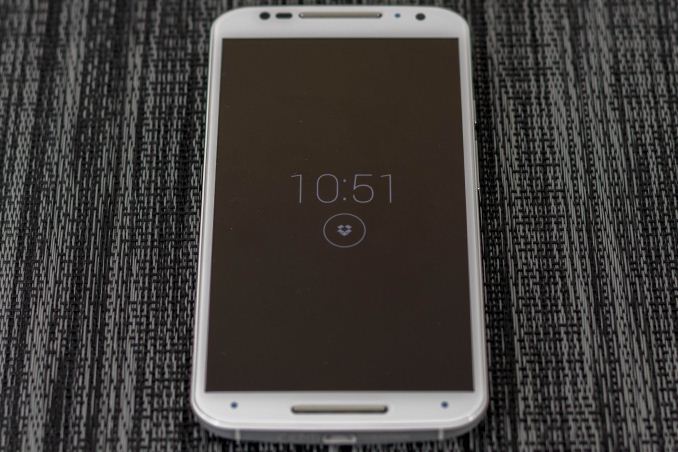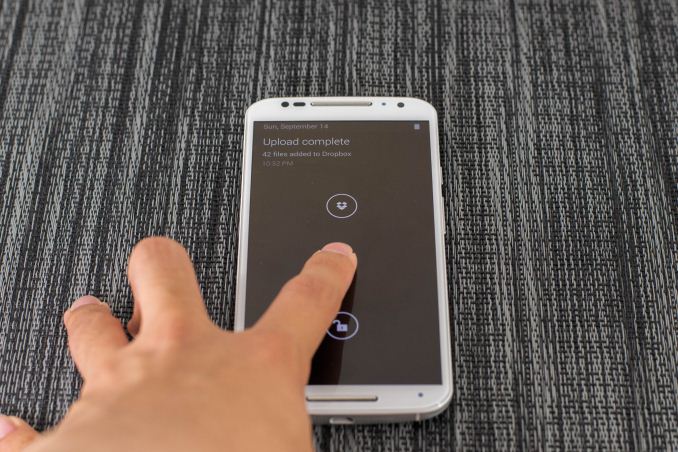The New Motorola Moto X (2nd Gen) Review
by Joshua Ho on September 17, 2014 9:00 AM EST- Posted in
- Smartphones
- Motorola
- Android
- Mobile
Moto Voice
One of the highlight features of the previous Moto X was Touchless Control, and Motorola spent a great deal of time trying to empahsize improvements in this feature with at the launch event. For those unfamiliar with Touchless Control in the previous Moto X, I would reference Brian's Moto X review. For those that don't want to read another review, the quick explanation is that Moto Voice acts as a voice command system, similar to Siri but with integration into Google Now and it works purely based on voice instead of long pressing a home button or a swipe gesture on the navigation keys. With the new Moto X, not too much changes, but there are some key features added. First, we see the ability to assign new keywords other than “Ok Google Now”, which is nice. I’m not really sure how this is enabled, as based upon some digging Motorola is still using a TI C55x DSP to enable low power hotword detection.
For the most part, other than this change I don’t really see a major step forward in functionality, although I’m sure that some will see a great deal of benefit from the voice-enabled selfie feature, which automatically opens the camera app with the countdown as seen above. Voice control continues to be an area where I’m unsure that there’s functionality to be had all the time. For the most part, I only seem to use voice control in situations where my hands are unable to manipulate the phone, which basically means when I’m driving or walking. For better or worse though, this is an area where wearables are much more effective. For example, it’s quick and easy to raise my wrist and ask for navigation to an event while driving compared to trying to reach into my pocket and carefully pull out my phone without dropping it under the seat. While explaining how this happens is a long story, the critical point here is that Moto Voice doesn’t really have a killer use case that isn’t done better by something else.
At any rate, the user interface also changes with the new Moto X. We see a great deal more color and a generally friendlier UI compared to the rather dark theme we saw before. Motorola seems to be following Android UI trends in general with this move, although it will affect battery life on AMOLED panels. The setup process is relatively simple, although there’s definitely a need for a quiet room. Even mild amounts of background noise will complicate setup. I also noticed that differing aural environments could alter the responsiveness of Moto Voice, although this could be due to the function turning itself on and off due to a bug in the ROM.
Moto Display
While Moto Voice is a bit limited in usability, Moto Display continues to be a great feature. For those that are unfamiliar with how Active Display worked in the previous Moto X, I would reference Brian's Moto X review again. For those that aren't familiar with Moto Display, this is effectively a low power mode in the Moto X that will display notifications and the time that also acts as a lockscreen. In order to support this low power mode, it isn't actually a part of Android OS and is programmed by a microcontroller so it isn't possible to take a screenshot of Moto Display.
While what we saw in the original Moto X was fantastic, the new Moto X takes things further by adding Moto Actions. While one part of Moto Actions is waving to silence alarms and phone calls, the other aspect allows for proximity to turn on Moto Display. This means that there’s no longer a need to shake the table or wiggle the phone in order to glance at notifications. While the original Moto X had a similar feature, it relied on the proximity sensor and required precise hand placement in order to turn on the display. Instead, with the new Moto X all that is needed is a hand wave or just getting close to the phone. It doesn’t really need to be accurate either, as pretty much any hand wave over the display will cause Moto Display to activate. In practice, handling of the notifications is still mostly similar, although now there’s the ability to display up to three notifications instead of just one.
While Active Display in the original Moto X was good, the new Moto X really turns it into a fantastic feature. It's hard to really explain because on the surface it seems rather mundane but after using Moto Display it's clear just how much time it saves. The glance time is just right to view notifications and the hand wave/approach action is effortless compared to pressing a home button or tapping the display. There's also no doubt that this helps to improve real world battery life as the seconds used to glance at notifications adds up quickly over time, especially because initial unlock will drive the CPUs to max power to ensure responsiveness.
If I’m honest, I’m not really completely sure how this new feature is implemented either. TI’s MSP430 is gone, and the part that seems to take its place is an STM401 sensor processor, which could be the solution used to enable Moto Display and also acts as a sensor hub. I'm not really sure what drove a change, but it's possible that the MSP430 limited feature expansion.














179 Comments
View All Comments
Jon Tseng - Wednesday, September 17, 2014 - link
Nice write-up on the semi content.One thing worth mentioning though might be the Moto Maker customisation options (which we're even getting in the UK!). Some of the premium leather/wood options definitely make the phone stand-out from competition (in a classy way, I might add).
semo - Thursday, September 18, 2014 - link
And once you get over oh la la nonsense you will wonder why you can't buy a more powerful aftermarket battery and why 1080p video recording is a chocolate teapot of a feature without an SD slot.It will be too late by then as you would have parted with your cash and voted for this trend to continue with your wallet. These nice things are only there to distract you from the planned obsolescence.
T1beriu - Wednesday, September 17, 2014 - link
I think the contrast graph is missing.JoshHo - Wednesday, September 17, 2014 - link
Infinite contrast would break the graph. :)s44 - Wednesday, September 17, 2014 - link
A small point... is it correct that only the *Sprint* version will have all the bands for full T-Mo operation when their version of 700mhz (Band 12) finally rolls out? I see Band 17 (due to be rolled into 12 at some point) listed on the GSM/Pure, and though perhaps a baseband update could enable 12, I know better than to expect that without an official announcement.Should full-price T-Mo buyers really be getting Sprint's X instead?
gg555 - Wednesday, September 24, 2014 - link
There's a lot of confusion out there about this. Also, given that Motorola tweeted a few days ago that there would be no Moto X for Sprint, it's not clear if model XT1092 actually exists or will ever be released.As far as I can see, only in this AnandTech review and a post at Android Central is there any mention of an XT1092 model. Also, on the Motorola site the XT1095 and XT1097 are not listed has supporting identical bands, as shown here at AnandTech. The XT1095 (Pure Edition) is show dropping a few of the LTE bands--which makes no sense to make a separate model that all it does is disable a couple bands.
Anyway, if the XT1092 does ever come to exist, as you note, it would be the best for T-Mobile because it supports LTE band 12 (700 Mhz)--which is just bizarre, given that the Pure Edition is being currently sold as the model for T-Mobile.
There's a thread in the Motorola forums where a company representative says they are aware of the confusion and looking into what is the deal with the bands on these phones, but no clarification has come yet.
https://forums.motorola.com/posts/d766a5d90a?page=...
djw39 - Wednesday, September 17, 2014 - link
Is there any thought that if the battery testing methodology ignores differences in devices due to the job scheduling setup and cell signal/wifi reception, that it is not giving the full picture? I'm sure the people at Motorola who worked on the antenna tuning are disappointed that you specifically exclude this from your tests.It seems like the LG G2 is a near-identical device with advantages over Moto in battery & camera. LG should just push their new UI skin out to that phone and keep selling it.
Impulses - Wednesday, September 17, 2014 - link
They made a G3 Mini or whatever that's basically a G2 rehash... Probably has a smaller battery tho, I forget.Problem with taking into account a job scheduler, varying signal conditions, etc is that it makes it near impossible to create a repeatable test with consistent results.
They could add ADDITIONAL tests like: battery life with borderline signal strength or battery life with a consistent sync job... But that would add to their already long battery of tests.
Plus where do you draw the parameters for tests like that (same signal strength for all phones or same scenario with varying low signal strength), and how do you keep it consistent (cell towers have varying loads, get upgraded, etc).
I suppose they could use that signal analyzer with the Faraday box Brian had for a while but I dunno if that could simulate a data traffic load.
leoblaze9 - Wednesday, September 17, 2014 - link
No love for the xperia z/z1/z2/z3 cameras at all??I was under the impression that they were among the best of the best cameras to be had in smartphones especially for android phones
adityarjun - Wednesday, September 17, 2014 - link
@Joshua Ho - A request: if possible please do the battery tests again once Android L is out for this phone.